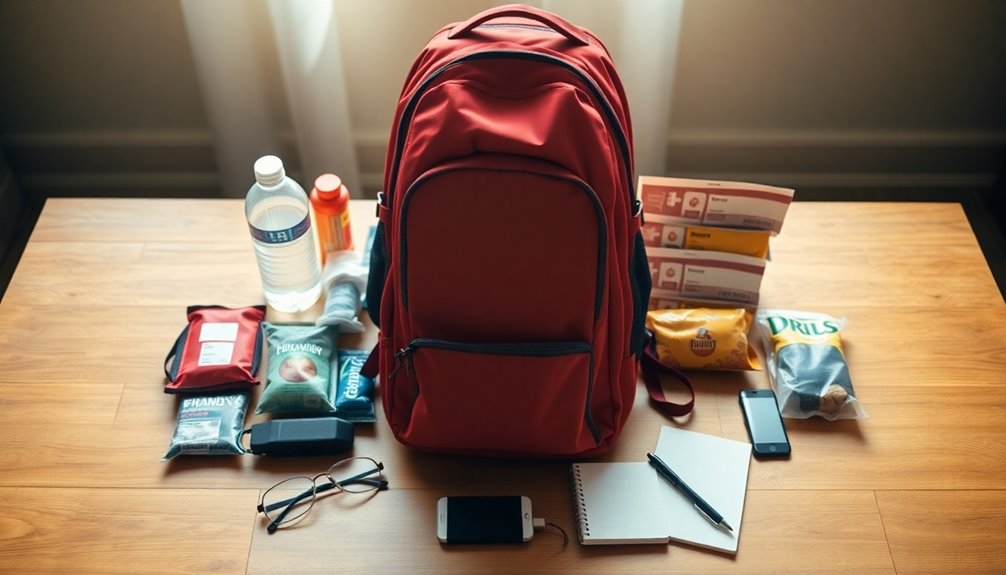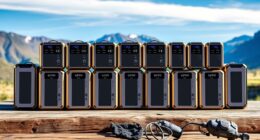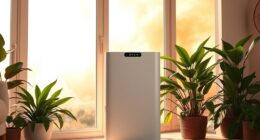When creating a senior-friendly emergency kit, make certain you include essential items like at least one gallon of water per person per day, a three-day supply of non-perishable food, and a seven-day supply of medications. Don't forget a detailed first aid kit, a reliable flashlight with extra batteries, and an easy access NOAA weather radio. Keep personal documents secure and pack comfortable clothing and extra blankets. If you're interested, there's even more to take into account for thorough preparedness.
Key Takeaways
- Include a seven-day supply of prescription medications and necessary medical supplies for chronic conditions to ensure health stability during emergencies.
- Pack non-perishable food items that are nutritious and easy to prepare, such as canned goods and granola bars.
- Incorporate a well-stocked first aid kit with essential supplies like bandages, antiseptic wipes, and personal medical items.
- Ensure access to water with a minimum three-day supply, storing it in a cool, dark place to maintain quality.
- Organize important personal documents in a waterproof container, along with a list of emergency contacts for quick access.
Water Supply
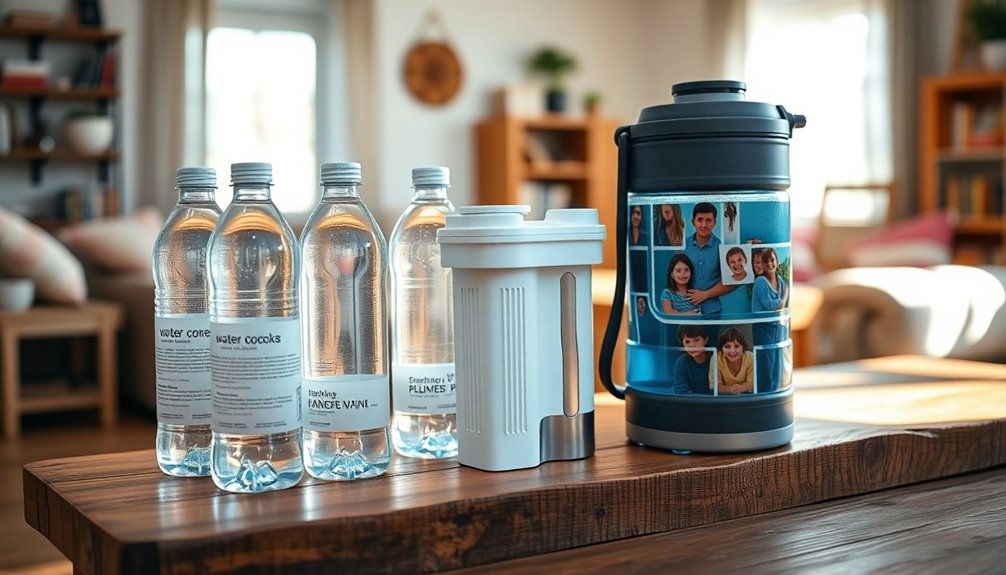
When preparing your senior-friendly emergency kit, make certain to include at least one gallon of water per person per day for a minimum of three days. This guarantees you meet both hydration and sanitation needs during emergency situations.
Choose bottled water with a long shelf life, or include water purification tablets to assure safe drinking water. Store your water supply in a cool, dark place to maintain its quality.
Don't forget to plan for extra water for hygiene and washing. It's essential to regularly check and rotate your water supply every six months, guaranteeing freshness and avoiding expiration.
Being proactive about your water needs can make a significant difference in an emergency.
Non-Perishable Food
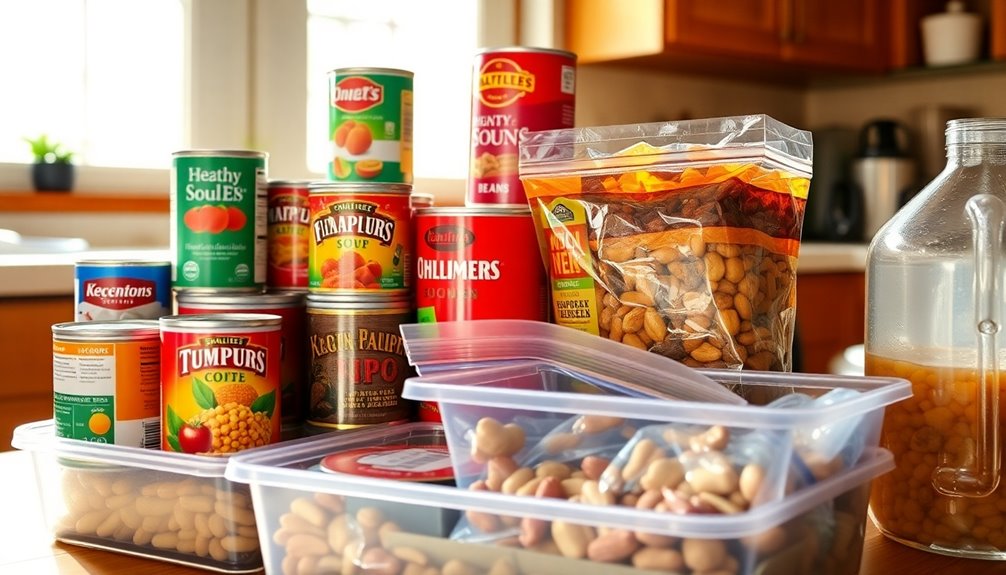
Non-perishable food is an essential component of your senior-friendly emergency kit, guaranteeing you have the nourishment needed during a crisis.
Aim to stock a minimum three-day supply of non-perishable food items to maintain adequate nutrition. Focus on nutritious choices like canned goods, dried fruits, and nuts, which offer energy without the need for cooking or refrigeration.
Lightweight and easy to store, granola bars and instant oatmeal are perfect for quick meals. Avoid high-sugar foods and those requiring extensive prep time to keep energy levels up with minimal effort.
Remember to regularly check expiration dates on all food items in your emergency kit to guarantee freshness and safety when you need it most. Additionally, including nutritious choices can help ensure that you meet essential dietary needs during emergencies.
Medications and Medical Supplies
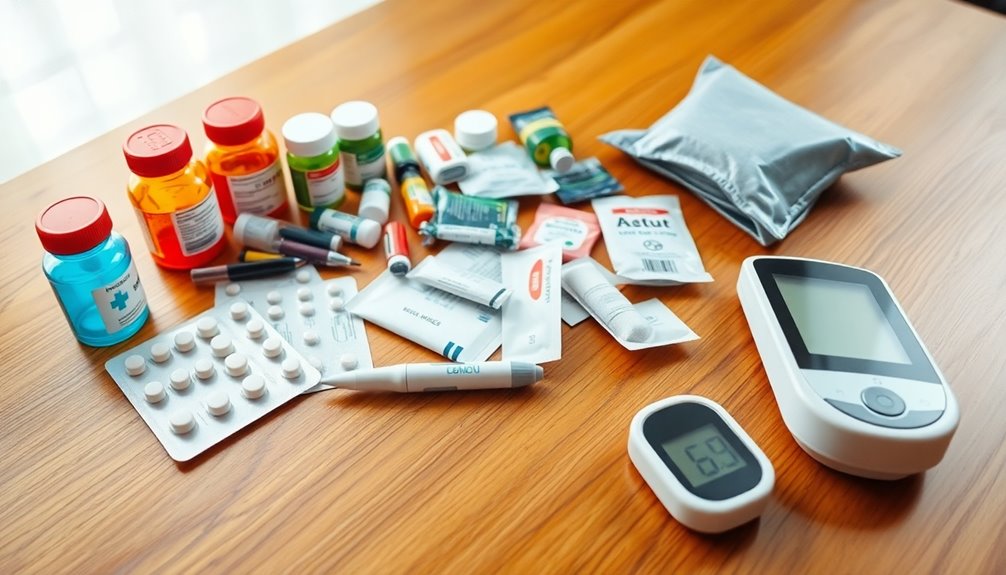
Stocking your emergency kit with medications and medical supplies is just as important as having enough non-perishable food.
You need to verify you're prepared for any situation by including a few essential items tailored to your health needs. Here's a quick list:
- Seven-day supply of prescription medications – This guarantees continuity of care.
- Glucose monitors or inhalers – Crucial for managing chronic conditions.
- Extra batteries – Keep your hearing aids and other devices functional during power outages.
- Spare glasses or contact lenses – Confirm you can see clearly, even if access to your usual items is disrupted.
Regularly check and update your emergency kit to make certain all medications and medical supplies are within their expiration dates.
First Aid Kit
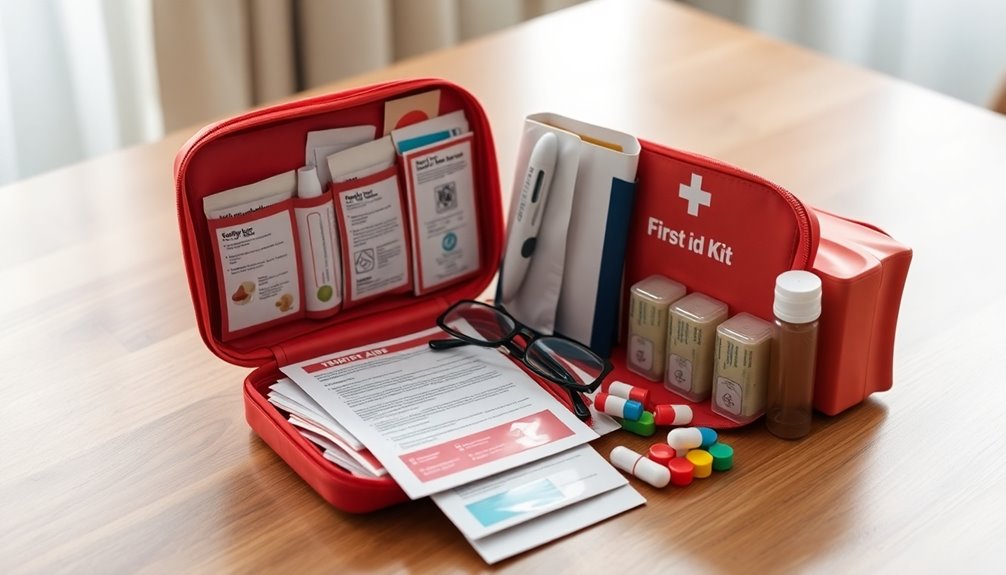
A well-equipped first aid kit is essential for seniors to handle minor injuries and emergencies effectively. Be certain to include adhesive bandages, antiseptic wipes, gauze pads, and adhesive tape to manage injuries.
Your kit should also contain personal medical items like prescribed ointments, diabetes supplies, and spare hearing aid batteries tailored to your needs.
Don't forget scissors and tweezers for easy removal of splinters or cutting bandages. Regularly checking and replenishing supplies guarantees that medications and items with expiration dates remain effective.
Finally, including a printed first aid manual can provide helpful instructions for common injuries, making it easier for you to respond in emergencies. Proper preparation enhances safety in senior living environments. Additionally, consider incorporating low-impact exercises to promote overall health and well-being.
Flashlight and Extra Batteries
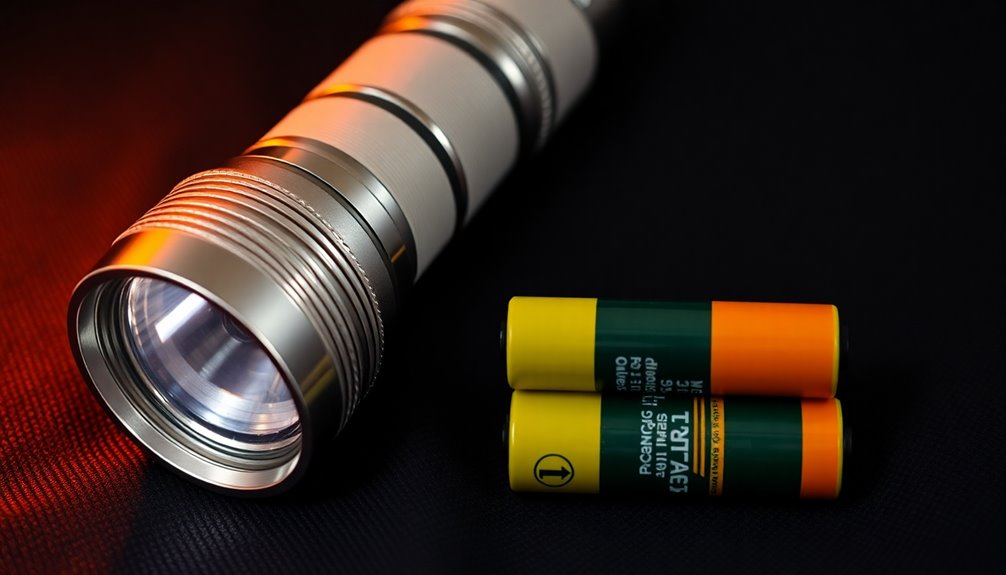
A reliable flashlight is essential for maintaining visibility during power outages, ensuring you can navigate safely in the dark.
Opt for an LED flashlight, as it offers a longer battery life, making it perfect for emergencies.
Don't forget to pack extra batteries so your flashlight stays ready when you need it most.
Visibility During Power Outages
When power outages strike, having a reliable flashlight at your fingertips can make all the difference in maintaining visibility and safety.
To guarantee your flashlight is functional and ready, keep these items in your emergency kit:
- LED Flashlight – Offers longer battery life and better brightness.
- Extra Batteries – Store fresh batteries to keep your flashlight operational.
- Accessible Storage – Place your flashlight in an easy-to-reach compartment of your emergency kit.
- Regular Checks – Periodically test your flashlight and batteries for functionality. Additionally, ensure your fire extinguisher is easily accessible during emergencies to enhance safety.
Long Battery Life Options
How can you guarantee your flashlight shines bright when you need it most? Start by investing in long battery life options like LED flashlights, which offer up to 100,000 hours of light. Always keep extra batteries in your emergency kit, ensuring they have a shelf life of 5-10 years. Rechargeable batteries are also a smart choice, as you can charge them in advance and reuse them. Don't forget a battery-operated radio for critical updates during outages. Regularly check and replace batteries to keep all functional devices ready.
| Device | Type | Lifespan |
|---|---|---|
| LED Flashlight | Long Battery Life | Up to 100,000 hrs |
| Extra Batteries | Non-Rechargeable | 5-10 years |
| Rechargeable Batteries | Cost-Effective | Multiple charges |
| Battery-operated Radio | Essential for Updates | Variable |
Radio
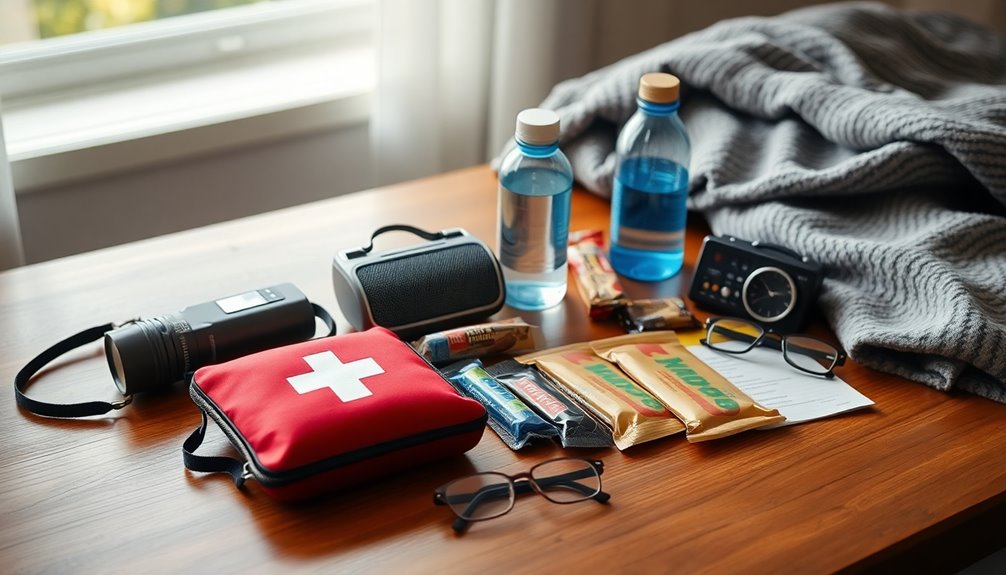
A reliable radio is essential for staying informed during emergencies, especially when power goes out.
You can choose between a battery-powered or hand-crank model, but verify it's easy to access for quick updates on weather alerts.
Keeping it handy in your emergency kit guarantees you won't miss important information when you need it most. Additionally, knowing how to maintain energy-efficient systems can help you optimize your home's safety during power outages.
Battery-Powered vs. Hand-Crank
Battery-powered radios are user-friendly, making them easier for seniors with limited strength or dexterity to operate. They also deliver superior sound quality for clear emergency updates.
On the other hand, hand-crank radios offer a sustainable power source during extended outages, guaranteeing you can stay informed without relying on batteries. Many hand-crank models come with added features, enhancing their utility.
Consider these must-have features for your emergency kit:
- Battery-powered radios for easy operation.
- Hand-crank radios for sustainable power.
- LED flashlights for visibility.
- USB charging capabilities for devices.
Having both types guarantees you're prepared for any situation! Additionally, having access to financial assistance programs can help seniors afford essential emergency supplies.
Weather Alerts Importance
Staying informed during emergencies is essential, and having a reliable radio in your emergency kit plays a key role in this. A weather radio, especially a NOAA Weather Radio, provides continuous broadcasts of critical weather information and emergency alerts from the National Weather Service.
This is particularly important for seniors during power outages when other communication methods may fail. With a radio, you can stay updated on potential evacuations, road closures, and safety advisories in your area.
It also helps you monitor changing weather patterns, enabling you to make informed decisions about your safety and evacuation plans. Don't forget to regularly check and maintain spare batteries to guarantee your radio functions when you need it most.
Easy Access Placement
When an emergency strikes, having your radio within easy reach can make all the difference. A battery-powered or hand-crank radio is essential for staying informed about weather updates and emergency instructions.
Here's how to guarantee easy access in your senior-friendly emergency kit:
- Choose a NOAA Weather Radio for timely alerts on severe weather conditions.
- Store it in an accessible compartment of your kit, so you can grab it quickly.
- Keep spare batteries nearby to guarantee it remains functional during power outages.
- Clearly label the radio and its compartment to help you locate it swiftly, even in high-stress situations.
With these steps, you'll be well-prepared to stay informed when it matters most.
Personal Documents
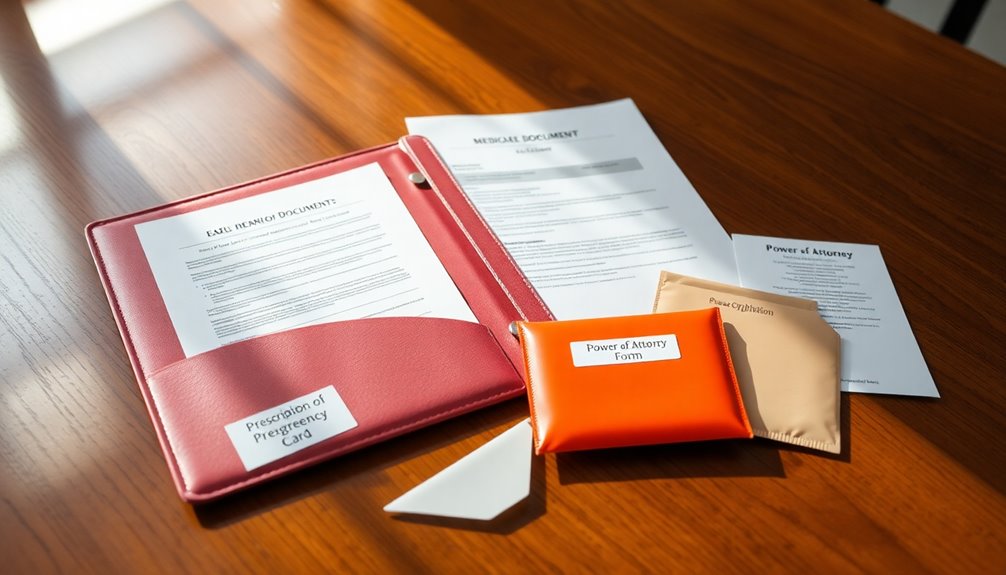
Having a well-organized collection of personal documents is essential for seniors during emergencies.
Store copies of important documents like IDs, insurance policies, and medical records in a waterproof container to protect them from damage.
Include a thorough list of emergency contacts, such as family members and medical providers, for quick access in crises.
Regularly update your personal documents to guarantee all information is current, especially regarding health conditions and medications.
Keep duplicates of critical documents in an easily accessible location, allowing you to retrieve them quickly if needed.
Avoid carrying original documents; instead, only store copies to reduce the risk of loss or theft during an evacuation.
Being prepared can make a significant difference in stressful situations. Additionally, maintaining a strong support network can help seniors navigate the emotional challenges that may arise during emergencies.
Clothing and Blankets

Comfort and safety during emergencies often hinge on the right clothing and blankets.
For older adults, having essentials in your emergency kit is vital for warmth and protection. Here are four must-have items:
- Weather-appropriate attire: Pack a change of clothes suited for the climate.
- Sturdy shoes: Make sure they're comfortable to help with mobility and prevent injuries.
- Blankets: Include extra blankets to provide warmth and shield against the elements.
- Waterproof bag: Store all clothing and blankets to keep them dry and accessible.
Frequently Asked Questions
What Are the 10 Essential Survival Kit Items?
When you're putting together a survival kit, focus on essentials that'll keep you safe and comfortable.
Start with one gallon of water per person per day and a three- to five-day supply of non-perishable food like canned goods.
Don't forget a first aid kit, important personal documents in a waterproof container, and a battery-powered or hand-crank radio for updates.
These items are vital for any emergency situation you might face.
What Are the 7 Supplies That Are Needed for an Emergency Supply Kit?
Creating an emergency supply kit is like packing for a long journey—you need the essentials to get through.
You'll want at least one gallon of water per person per day, plus non-perishable food for three days.
A first aid kit is vital, along with any necessary medications.
Don't forget to include personal documents in a waterproof container.
Finally, consider a flashlight with extra batteries to stay prepared in the dark.
What Are 20 Things You Would Find in an Emergency Kit?
In an emergency kit, you'd find essential items that guarantee your safety and comfort.
You should include non-perishable food, water, a flashlight, batteries, a first aid kit, and personal hygiene products.
Don't forget important documents in a waterproof container, a multi-tool, a whistle, and a battery-powered radio.
Pack warm blankets, a phone charger, and any necessary medications.
Having these supplies ready helps you stay prepared during unexpected situations.
What Is Emergency Kit Checklist?
When it hits the fan, you need an emergency kit checklist.
Start with a three-day supply of water—aim for a gallon per person daily.
Stock up on non-perishable foods that're easy to prepare, like canned goods.
Don't forget a first aid kit packed with essentials.
Keep a week's worth of meds handy, too.
Finally, store your important documents in a waterproof container.
You never know when you'll need 'em!
Conclusion
As you gather these essential items for your senior-friendly emergency kit, imagine the peace of mind they'll bring in a crisis. Picture yourself reaching for that flashlight when darkness falls, or finding comfort in a warm blanket when the temperature drops. What if the unexpected happens? You'll be ready. Don't wait until it's too late—prepare now, and guarantee that you and your loved ones are protected against whatever challenges may come your way.
